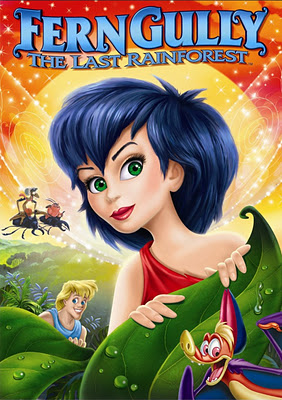If you’re the parent of a child who has outgrown mindless fare like the Teletubbies but not quite ripened toward Harry Potter levels of sophistication, stumbling upon a film like Ferngully: The Last Rainforest to share with your family must be nothing short of an epic “Eureka!” moment. Released in 1992, this movie has managed to simultaneously entertain and educate young minds for close to 20 years. It upholds within the Western film canon something of a timeless, iconic quality for those in the age group most likely to become Wall Street Occupiers. Indeed, a trip beneath the leafy canopy of Ferngully, a lush, fictitious rainforest set in the Australian outback, always proves a nostalgic harkening back to that brief period in animated film history when female protagonists were front and center, relative to the action. At the same, its the sort of film that presents an upbeat outlook for young viewers, regarding the many ways that a world stripped of suffocating gender norms could help build an egalitarian playing field.
At such an empowering crossroads do we find Ferngully, a stunningly animated early ‘90s classic that preaches an important lesson on environmental protection in the simplified language of children. Leading the charge is Crysta, a spunky, quasi-adolescent forest fairy who begins the film frivolous and carefree, but finishes it as a respected leader among the forest sprite community. Alongside her mentor Magi Lune, the two flit about Ferngully’s dense and lovely layers of vegetation, using their combined magical powers to conjure up the forces of nature and help all sorts of exotic plants grow. Things turn problematic, however, when an evil, primordial force of destruction – a demonic smog cloud called Hexxus, voiced by Tim Curry in always reliably flamboyant Dr. Frank mode – is released from his tree prison, trapped there generations earlier by Magi, to wreak havoc on the serene oasis of Ferngully. Its perhaps no coincidence that the moniker “Hexxus” sounds like it could double as a brand name for a major chain of gas stations, seeing as how the villain spends the bulk of his time on screen sucking down human produced poisons and plotting how best to capitalize on manmade machinery, to aide in Operation: Rain Terror. (And acid rain.) Assisting Crysta and co in the struggle against Hexxus are Batty Koda, a fruit bat who has been experimented on by humans and has the voice of Robin Williams, among other afflictions, and Zak Young, a hunky human forester whom Crysta accidentally shrinks down to fairy size while trying to protect him from a rapidly falling tree aimed at his head. (Obviously, shouting “timber!” is not a phrase found in fairy vernacular.) And of course, there’s the aforementioned Magi Lune, whose flowing, matronly robes provide an early contrast to Crysta’s biker chick meets lady Tarzan look.
But, in spite of their differences, the movie’s climactic sequence finds the two female protagonists dovetailing in strength of character, each embarking upon a courageous suicide mission of self-sacrifice for the benefit of all. In Magi’s own parting words, “We all have a power and it grows when it’s shared,” the sort of sentiment that lends vocal credence to one of Ferngully’s most prominent tropes: we all have the ability to make positive change, but that power multiplies when there is community cooperation readily at hand.
Through it all, the film presents a very positive perception of female role models, set amidst a piece of media targeting an impressionable audience. In classical tradition, coming of age quests don’t often revolve around a heroine, preferring instead to linger in strict hero territory. (Here’s looking at you, J.R.R.) But Crysta, she of the spunky, tomboyish haircut and quick giggle, does just that – growing from a lackadaisical teen to a noble warrior, willing to die for the sake of protecting the forest community. And the fairies themselves, in a number of ways, appear to be a genderless society: over the course of the movie’s scant 75 minutes, there is no talk of getting serious about marriage, children, or domestic obligations. There is only the reinforcement of protecting one’s home and working for the benefit the place you call home. Perhaps the message here could even be interpreted thusly: free from the confines of limiting gender roles, the forest fairies are better able to practice magic and serve the planet.
Probably the worst you could say about Ferngully’s representation of gender is that its main motif gently reiterates some stereotypes about the nurturing quality of women and and the rough, aggressive nature of men, but, in my view, the use of female characters as the plot’s central exemplars more than compensates for this small fact. Ferngully is where good environmental stewardship and positive female role models meet. It’s a film that surely has more uplifting things to say about approaching the working world than any lesser, gender norm promoting contemporaries might.
Emma Kat Richardson is a Detroit-reared freelance writer living in Austin, Texas. Her work has appeared in Bitch, Laugh Spin Magazine, 944, Alternative Press, Real Detroit Weekly, and on Bust.com.

